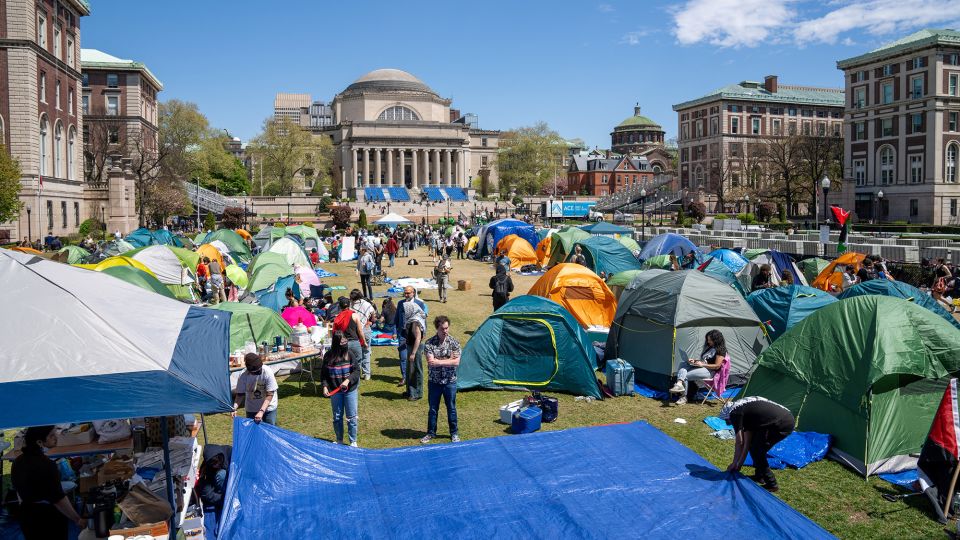
COLUMBIA’S STUDENT JOURNALISTS PRODUCED NEW YORK MAGAZINE’S COVER STORY. HERE’S HOW THEY DID IT
Editor’s Note: A version of this article first appeared in the “Reliable Sources” newsletter. Sign up for the daily digest chronicling the evolving media landscape here.
In mid-April, when New York magazine sought to report on the pro-Palestinian student protests engulfing Columbia University, the features editor overseeing the storied publication’s coverage devised an outside-the-box approach.
Rather than dispatching his own staff writers to the Morningside Heights campus, the editor, Nick Summers, tapped away at his keyboard, writing an email to Isabella Ramirez, the editor-in-chief of Columbia Daily Spectator.
The Spectator, the student newspaper that has served the university since 1877, had been all over the story — and Summers was hoping to tap into its network of sources, deep knowledge of the campus community, and trust its staff had amassed over the years among students and faculty for New York’s May issue.
“It was clear from the outset that The Spectator was really leading the coverage,” Summers told CNN by phone Monday. “And so, we had the idea to approach them and offer: Do you want to make the next cover package?”
The final product, out Monday, is a special report on the campus unrest, executed in total partnership with The Spectator. It includes an oral history of the encampments and Hamilton Hall takeover, portraits of both pro-Palestinian and pro-Israel demonstrators, and a 700-person poll of the campus community.
The package was not only written in its entirety by the student journalists, but it was edited by Ramirez who worked hand-in-hand with Summers and another features editor, Ryu Spaeth. The photographs were captured by student journalists — including the cover image shot by freshman Stella Ragas — working in conjunction with New York photo director Jody Quon.
“They delivered a depth of reporting that exceeded our expectations,” said Summers, who once served as the top editor at The Spectator himself.
Working with the magazine also allowed the students to learn from top industry veterans, who Quon told CNN, took joy in passing along tips to the next generation of journalists. Quon relayed a story from when she visited campus to help with the photography process. She said she introduced some students to top industry photojournalists, who took time to offer their advice.
“I was so warmed by that,” Quon said.
Gathering reporting from campus for the issue, however, was not without its challenges for the student journalists. The Spectator’s staff is comprised, obviously, of students — and the protests reached the crescendo just as finals approached and end-of-the-semester papers were due. Adding to the stress was the fact that many student demonstrators have been press shy, expressing skepticism that the news media has accurately portrayed their views.
That also gave The Spectator an edge over just about everyone else. The protesting students who wanted to speak to the media were far more likely to trust their fellow classmates than the hordes of reporters from national and international news organizations who had descended on the campus.
“There is significantly more trust of us than national outlets who parachute in and maybe don’t have the intimate knowledge,” Ramirez told CNN.
“We have been covering this since October 7. We have been here before, during, and we will be here after,” Ramirez added. “And I think what that means is we have cared about this storyline even before the peak of escalation. And so we spent months forming our connections with the organizers.”
For the journalists at The Spectator, offering the campus community an unrelenting stream of updates about the tense and politically polarizing situation carried with it a strong sense of duty. And so, they have spent the last several weeks pouring their souls into the coverage.
In fact, when the encampments first propped up on campus, Ramirez told CNN that the student journalists were reluctant to retire for the night. For the first few days, they remained tirelessly on scene. Ultimately, a shift system was put into place that allowed reporters and editors to continue delivering updates on the protests on a rolling, 24/7 basis.
“Someone needs to do the history keeping, the record keeping,” Ramirez said.
While The Spectator churned out non-stop breaking news alerts, the partnership with New York magazine allowed the journalists to “take a step back and explore a long form medium,” Ramirez said. She said the “ability to do something incredibly comprehensive” added important context into the historical record.
“I think it will stay for us forever,” Ramirez said, “and I hope it will stay with our community forever.”
For more CNN news and newsletters create an account at CNN.com
2024-05-07T11:29:34Z dg43tfdfdgfd